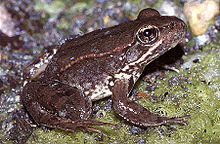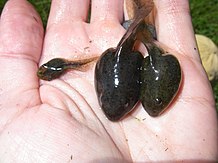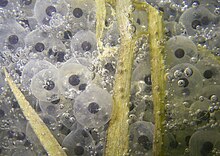California red-legged frog
| California red-legged frog | |
|---|---|

| |
| Scientific classification | |
| Domain: | Eukaryota |
| Kingdom: | Animalia |
| Phylum: | Chordata |
| Class: | Amphibia |
| Order: | Anura |
| Family: | Ranidae |
| Genus: | Rana |
| Species: | R. draytonii
|
| Binomial name | |
| Rana draytonii | |
| Synonyms[3] | |
TheCalifornia red-legged frog(Rana draytonii) is aspeciesoffrogfound inCalifornia(USA) and northernBaja California(Mexico). It was formerly considered asubspeciesof thenorthern red-legged frog(Rana aurora).[4]The frog is anIUCNnear-threatened speciesas of 2021,[1]has aNatureServe conservation statusofImperiledas of 2015,[2]and is a federally listedthreatened speciesof the United States that is protected by law.[5][6]
Distribution
[edit]The California red-legged frog is found in California and extreme northernBaja California,northwestern Mexico.[1]This species now occurs most commonly along the northern and southernCoast Ranges,and in isolated areas in the foothills of theSierra Nevadamountains.[1]The current southernmost California populations are on theSanta Rosa PlateauinRiverside County,and within theUpper Las Virgenes Canyon Open Space Preservein theSimi Hillsin eastern Ventura County, near the community ofWest Hills.[1][7]In 2015, egg masses from the nearby Simi Hills were introduced to two streams in theSanta Monica Mountains.Juvenile frogs were found living at the locations a year later.[8][9]
Description
[edit]
R. draytoniiis a moderate to large (4.4–14 cm or 1.7–5.5 in) frog. It is the biggest native frog species in the western United States.[10]The back is a brown, grey, olive, or reddish color, with black flecks and dark, irregular, light-centered blotches, and is coarsely granular. A dark mask with a whitish border occurs above the upper jaw, and black and red or yellow mottling is in the groin. The lower abdomen and the undersides of its hind legs are normally red. The male can be recognized by its large fore limbs, thumbs, and webbing. Only a portion of the toes are webbed, and it uses vocal sacs to grunt during breeding season.[10]The juvenile frog has more pronounced dorsal spotting, and may have yellow, instead of red, markings on the undersides of the hind legs. A characteristic feature of the red-legged frog is its dorsolateral fold, visible on both sides of the frog, extending roughly from the eye to the hip.R. draytoniilooks very similar to the northern red-legged frog.
Ecology and behavior
[edit]This species has disappeared from an estimated 70% of its range, and is now only found in about 256 streams or drainages in 28 counties of California.[11]However, the species is still common along the coast, and most of their population declines are in the Sierra Nevada and Southern California. The California red-legged frog is an important food source for the endangeredSan Francisco garter snakeinSan Mateo County.TheCalifornia newtis often found with this species due to sharing habitat requirements and the newts eating their eggs.[12]The California red-legged frog primarily eats earthworms, beetles, flies, and other winged insects. There have been instances where the species was viewed preying on juvenile snakes, small mammals such as mice, and other frogs and tadpoles.[13]
Breeding occurs from late December to early April.[10]The male frog's advertisement call is a series of a few small grunts, usually given while swimming around under water. Choruses are weak and easily missed. The adult California red-legged frog is nocturnal, while juvenile frogs are both nocturnal and active during the daytime.[10]The species inhabits dense, shrubby, or emergent riparian vegetation and still or slow-moving perennial and ephemeral water bodies that also serve as breeding sites. This species has been noted to utilize upland habitats as adults near aquatic areas (such as creeks). They often use these zones for basking and searching for prey.[14]They prefer tall plants such as cattails for protection and to lay eggs.[10]
The tadpoles (larvae) of this species may metamorphose into frogs within about 7 months of hatching from the egg, or may overwinter, taking up to 13 months.[15]This is a recent discovery, which may have management implications for the species, particularly when aquatic habitat undergoes modification.
The California red-legged frog exhibits several behaviors when approached by predators. They either stay immobile, quickly leap into vegetation in an upland habitat or a water source nearby, or, rarely, give off an alarm call to indicate danger. They have also been seen demonstrating theunken reflexwhen caught.[16]
Conservation
[edit]

This frog is listed as threatened and is protected by federal[5][6]and California law. One cause of the population decline is habitat loss and destruction, butintroducedpredatory species, such asAmerican bullfrogs,might also be a factor. Their habitats are in close proximity to roads and trails, indicating traffic, runoff, pollution, and other human interference may be a significant threat to the species. The species has also been found thriving in undisturbed and isolated ponds in comparison. Vegetation diversity and surface coverage on smaller ponds indicate a greater likelihood of the species being present.[12]
- 2006
After years of litigation initiated by land developers' organizations, specifically theHome Builders Association of Northern California,and scientific back-and-forth, theUS Fish and Wildlife Serviceannounced in April 2006 the designation of about 450,000 acres (1,800 km2) of critical California habitat for the threatened frog. This protected habitat did not include any land inCalaveras County,the setting ofMark Twain's short story, "The Celebrated Jumping Frog of Calaveras County",which features this species.
- 2008
On September 17, 2008, the US Fish and Wildlife Service proposed to more than triple the habitat of the California red-legged frog, citing political manipulation by former Deputy Assistant SecretaryJulie MacDonaldat theUnited States Department of the Interior.According to theLos Angeles Times,"development and destruction of wetlands have eliminated the frogs from more than 70% of their historic range. MacDonald would have reduced what was left of the frog's range by 82%."[17]San Mateo County andMonterey Countyseem to have some of the largest healthy populations of these frogs, especially in coastal wetlands.[18][19]
- 2010
In March 2010, the US Fish and Wildlife Service announced 1,600,000 acres (6,500 km2) of protected land for the species throughout California, which has implications regarding development and use of such land.[1][20][21]The largest population of the frog will be given protection on a 48-acre stretch of land (19 ha) inPlacer County.[22]
- 2015
A new law designates the California red-legged frog the “state amphibian.” Presently, it is subject to protection under both federal and state laws passed in 1996. Although the designation as official state amphibian does not provide legal protection to the frog as a threatened species, it does highlight the importance that California places on the frog's preservation.[23]
References
[edit]- ^abcdefIUCN SSC Amphibian Specialist Group (2022)."Rana draytonii".IUCN Red List of Threatened Species.2022:e.T136113A53990036.Retrieved25 December2022.
- ^abNatureServe (6 January 2023)."Rana draytonii".NatureServe Network Biodiversity Location Data accessed through NatureServe Explorer.Arlington, Virginia: NatureServe.Retrieved8 January2023.
- ^"Rana draytoniiBaird & Girard, 1852 ".Global Biodiversity Information Facility.Retrieved20 February2023.
- ^Frost, Darrel R. (2018)."Rana draytoniiBaird and Girard, 1852 ".Amphibian Species of the World: an Online Reference. Version 6.0.American Museum of Natural History.Retrieved31 December2018.
- ^ab"California red-legged frog (Rana draytonii) ".Environmental Conservation Online System.U.S. Fish & Wildlife Service.Retrieved28 April2023.
- ^ab61FR25813
- ^Federal Register: "Endangered and Threatened Wildlife and Plants: Revised Designation of Critical Habitat for California Red-Legged Frog; Final Rule"Archived2018-11-07 at theWayback Machine.pg. 3 of pdf. accessed 6.16.2013
- ^Carlson, Cheri (June 15, 2015)."Gone for decades, red-legged frogs surviving in Santa Monica Mountains".Ventura County Star.Retrieved5 March2016.
- ^DWORETZKY, JOE (2019-07-25)."The threatened frogs of the Santa Monica Mountains always had it hard. The Woolsey fire made things much worse".Los Angeles Times.Retrieved2019-07-25.
- ^abcdeGarbus, Julia (2016).U-X-L endangered species: Amphibians, Corals, Fish, Plants, and Reptiles.Noah Berlatsky, Kathleen J. Edgar, Gale (3rd ed.). Farmington Hills, Mich.: Gale. pp. 572–575.ISBN978-1-4103-3296-7.OCLC933889215.
- ^Recovery Plan for the California Red-legged Frog (Rana aurora draytonii)(PDF)(Report). Portland, Oregon: U.S. Fish and Wildlife Service. 2002.Retrieved2013-04-03.
- ^abAnderson, Rachel B. (2019-03-07). De Marco Júnior, Paulo (ed.)."Human traffic and habitat complexity are strong predictors for the distribution of a declining amphibian".PLOS ONE.14(3): e0213426.Bibcode:2019PLoSO..1413426A.doi:10.1371/journal.pone.0213426.ISSN1932-6203.PMC6405065.PMID30845170.
- ^Bishop, Meghan R.; Drewes, Robert C.; Vredenburg, Vance T. (2014). "Food Web Linkages Demonstrate Importance of Terrestrial Prey for the Threatened California Red-Legged Frog".Journal of Herpetology.48(1): 137–143.doi:10.1670/12-288.ISSN0022-1511.S2CID86398970.
- ^Alvarez, Jeff A.; Wilcox, Jeffery T. (2021). "Observations of Nocturnal Upland Habitat Use by the Rana Draytonii (California Red-Legged Frog), and Implications for Restoration and Other Activities".Ecological Restoration.39(3): 155–157.doi:10.3368/er.39.3.155.ISSN1543-4060.S2CID236970675.
- ^Fellers GM, Launer AE, Rathbun G, Bobzien S, Alvarez J, Sterner D, Seymour RB, Westphal M (2001). "Overwintering tadpoles in the California red-legged frog (Rana aurora draytonii) ".Herpetological Review.32:156–157.S2CID81756914.
- ^Alvarez, Jeff A.; Haire, Jennifer L. (2021-12-27)."Unken Reflex in the California Red-legged Frog Rana draytonii in Western North America".Bulletin, Southern California Academy of Sciences.120(3): 132–134.doi:10.3160/0038-3872-120.3.132.ISSN0038-3872.S2CID245386391.
- ^Cart, Julie (17 September 2008).Room to stretch a frog's red legs.Los Angeles TimesRetrieved 28 April 2023.
- ^"California Red-Legged Frog".Wild Equity Institute. Archived fromthe originalon March 5, 2016.RetrievedAugust 29,2011.
- ^"California Red-Legged Frog"(PDF).California Department of Pesticide Regulation. 2002. Archived fromthe original(PDF)on May 25, 2017.RetrievedAugust 29,2011.
- ^Barnett, Lindsay (16 March 2010)."Endangered California Red-Legged Frog to Receive Large New Protected Habitat Area - Finally".Latimesblogs.latimes.com.Retrieved28 April2023.
- ^.PDF Maps of Northern and Southern Protected Ranges via FWSArchivedMay 13, 2008, at theWayback Machine
- ^Perlman, David (24 November 2010).Red-legged frogs get 48-acre preserve in Sierra.—San Francisco ChronicleRetrieved 28 April 2023.
- ^Assembly Bill 2364 codified as Government Code §422.7. Effective January 1, 2015.
"California red-legged frog named state amphibian".KPCC.Associated Press. 7 July 2014. Archived fromthe originalon 28 April 2019.Retrieved1 January2015.
"New California laws for 2015: Frogs, drones, Confederate flags".Los Angeles Times.1 January 2015.Retrieved1 January2015.
Further reading
[edit]- Hillis, D.M.; Wilcox, T.P. (2005)."Phylogeny of the New World true frogs (Rana) "(PDF).Mol. Phylogenet. Evol.34(2): 299–314.Bibcode:2005MolPE..34..299H.doi:10.1016/j.ympev.2004.10.007.PMID15619443.Archived fromthe original(PDF)on 2008-05-28.Retrieved2008-03-09.
- Shaffer, Bradley H.; Fellers, Gary M.; Voss, S. Randal; Oliver, Jeff; Pauly, Greg (2004). "Species boundaries, phylogeography, and conservation genetics of the red-legged frog (Rana aurora/draytonii) complex".Molecular Ecology.13(9): 2667–2677.Bibcode:2004MolEc..13.2667B.doi:10.1111/j.1365-294x.2004.02285.x.PMID15315679.S2CID30926564.
- "A Field Guide to the Reptiles and Amphibians of Coastal Southern California"—by Robert N. Fisher and Ted J. Case, USGS.
- Barry, Sean J.; Fellers, Gary M. (2013)."History and Status of the California Red-Legged Frog (Rana draytonii) in the Sierra Nevada, California, USA "(PDF).Herp. Conser. Biol.8(2): 456–502.
External links
[edit]- "A Field Guide to the Reptiles and Amphibians of Coastal Southern California" —Rana draytonii—article + images.
- U.S. Fish and Wildlife Service: California red-legged frog
- SF-NPS:Rana draytonii(California Red-Legged Frog)Archived2018-11-07 at theWayback Machine—detailed description and habitats.
- Washington Post: "Calif. Frog at Center of Protection Debate"
- IUCN Red List near threatened species
- NatureServe imperiled species
- Rana (genus)
- Amphibians of the United States
- Amphibians of Mexico
- Fauna of the California chaparral and woodlands
- Fauna of the Sierra Nevada (United States)
- Fauna of the Baja California Peninsula
- Amphibians described in 1852
- ESA threatened species
- Taxa named by Spencer Fullerton Baird
- Taxa named by Charles Frédéric Girard
- Symbols of California


